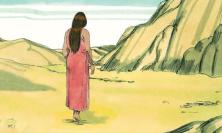The advice of a celebrated fashion designer may not have been directly derived from the Hebrew Bible, but it certainly has strong echoes therein. If you want to know if, and what, God thinks about what you wear, Karen Eliasen suggests you consider how warriors, ‘capable wives’ and even God are clothed in scripture. Is there a dress code in the Bible?
There is a dress code specification in the ‘Handbook of Useful Information for St Beuno’s Directors and Visiting Directors’ that runs like this: ‘It is important that the style of dress worn by staff conforms to what is reasonably expected within professional circles and within Church circles. As a director casual clothing (t-shirts, jeans, cut offs, old shoes) should not be worn to work.’ As one such director working at St Beuno’s, a Jesuit Spirituality Centre, I can only observe that this handbook specification is one thing, and my own reality is another. I wear, almost all the time, a t-shirt, jeans and old shoes. Not that anyone here has ever confronted me on any of these matters, but I am nevertheless intrigued by the relationship between who we are, what we do, and the clothes we wear. The question for me, however, relates not so much to the St Beuno’s Handbook on ‘style of dress’ as to God’s opinion on what I wear.
Some people with strong opinions on clothes styles like to quote scripture chapter and verse. Scripture obviously has nothing to say about t-shirts and jeans. What scripture, at first glance, does have something to say about when it comes to clothes is colour. Scripture, especially the Hebrew Bible, also has some hefty words about gender and God’s wrath in relation to clothes, but colour is a good starting point. If we are looking to the Hebrew Bible not to uphold strong opinions about clothes styles, but to explore what God’s interest in clothes is beyond styles, then there is, literally, a red thread to be followed from God to warrior to ‘capable wife’.[1]
Should anyone suspect that any interest in clothes and fashion is either frivolous or depraved, there is a third kind of interest in clothes possible. A well-known popular midrash on how Jews have managed to survive against overwhelming historical odds for so long links this survival directly to clothes: ‘We were led out of Egypt because we kept three things intact: name, clothing, language. By clinging to our names, our distinctive dress, and our language, we merited rescue from Egypt.’ Further questions are to be asked here, because deeper down the link between ‘we’ and ‘our distinctive dress’ is ambiguous. If it is true that ‘clothes make the man’ (a centuries-old anonymous quote that Mark Twain expanded with the observation that ‘naked people have little or no influence on society’), then where do these distinctive clothes come from? The Greek Stoics considered this the proper sequence: ‘Know, first, who you are; and then adorn yourself accordingly’ (advice from Epictetus [d. 135 AD]). It is an ambiguity that we find at play in the Hebrew Bible – wherein we read all about that ‘rescue from Egypt’, along with its enduring after-shocks, including the giving of laws on what clothes to wear. The rescue and the clothes-laws are not so readily separated, so it comes as no surprise that the Hebrew Bible has plenty to say about how clothes relate to identity as belonging to God and therefore meriting rescue, both literally and metaphorically.
‘When in doubt, wear red’, was the much-quoted advice from the late American fashion designer Bill Blass to his clients.[2] It was advice from someone who believed that a designer should under no circumstances be a dictator, but rather should acknowledge that ultimately the client, the wearer of his designs, was in charge. As a great designer, Blass by all accounts had a knack for designing flattering, classic clothing that women wanted to wear: his clothes were beautiful and timeless, comfortable and casual, and of the highest craftsmanship, custom-tailored to the client. Who would not want to wear such clothes? I like to imagine that God as a clother of us humans can always outdo a 20th century secular fashion designer, certainly in terms of both beauty and comfort; but I also like to imagine God nodding in assent to those words: ‘When in doubt, wear red’. I can imagine that, because there are some clues about red clothes in the Hebrew Bible to that effect. The strongest of these clues appears in Proverbs in chapter 31, in which we find the well-known poem praising the character of the eshet chayil, literally the ‘woman of force’.[3] The Hebrew term has many translations, but the most familiar one is probably ‘capable wife’ (NRSV). Other translations range from the suspect (‘virtuous woman’ in the KJV) to the extraordinary (‘strong woman’ in the Wycliffe Bible), but all are attempts to apply to a woman a common force-term most often applied to men on the battlefield. In Proverbs, the context is not the battlefield, but the peaceful household: the eshet chayil is a woman who ‘is not worried for her household because of snow, for her whole household is dressed in crimson.’ (Proverbs 31:21)
Much can be made of this capable/strong woman’s relationship to crimson red clothes as well as to her masculine epithet, but before delving further into that relationship, there is another biblical woman to contend with – Eve. We all know how biblical humans did not start out wanting to wear clothes – clothes of any kind, be they beautiful or comfortable or red or otherwise. Biblical humans started out naked, and contentedly so, in the first chapters of Genesis. But we all know, too, that this contentedly naked state did not last long: halfway through the third chapter of Genesis, clothes become a non-negotiable must-have in a fallen world. This we learn about humans from the scriptural story, but we learn nothing about God’s state of dress in those first few chapters of Genesis. Perhaps it is possible to imagine a naked God, the same God who created humans in his own image, greeting Adam and Eve in the Garden on that fateful ‘breezy time of day’ when clothes first appear. But there is no record of anyone ever imagining God naked. Several centuries worth of religious art attest to quite the opposite, that of imagining a God sumptuously dressed in robes and cloaks that are sometimes white, sometimes blue, most often red, but always elegantly billowing. From the early Middle Ages to late Baroque, red clothes dominate in paintings of God, especially in paintings involving Adam and Eve in Eden.[4] In looking at these striking images of God in red, it is worth noting some observations about the colour red and how we engage with it.
The associations that red carries are ancient, numerous, ambivalent and contradictory. Yet all these associations in some way are straddled by one umbrella issue: the issue of power, especially power over life and death. Blood is what tells the tale, and so it is that we experience red both as a go-ahead signal and as a warning-off signal. On both fronts, red stimulates the nervous system and cannot be ignored; seeing red requires action, towards or away from. Red can beckon us to passion, courage, to eros in its most creative sense, to life; and red can warn us of danger, of hell and doom, of death. Red, in all these capacities, is the most oft-mentioned colour in the Hebrew Bible, where its dual role as symbolically carrying both death and life is complex. This becomes apparent when we explore more closely how red clothes actually figure in the Hebrew Bible. As we shall see, it may not at all be so farfetched that a ‘capable wife’ in charge of a peaceful household should be an expert in the complexities of red clothes.
In the biblical story, Eve does not encounter a clothed God. Textually rather than imaginatively speaking, it is only much later that a clothed God makes a couple of rare appearances, and in one of these his clothes are red. ‘Why is your clothing so red, your garments like his who treads the grapes?’ asks the prophet Isaiah (63:1-6), only to get a horrifying answer: ‘I trampled peoples in my anger … Their life-blood bespattered my garments.’ This is God the justice-seeking avenger writ large and powerful and clothed in bloodied garments. But human avengers, not as metaphoric grape-treaders but as warriors, as literal people-killers, are also described, elsewhere in the Prophets, as wearing red. The prophet Nahum, in a short, extremely violent poem about the destruction of Nineveh, describes the men carrying out God’s orders to wipe out the city: ‘His warriors’ shields are painted red, and the soldiers are clothed in crimson.’ Both the Isaiah text and the Nahum text capture God in the full flow of righteous anger taking divine justice to its most extreme: violent, bloody death. Whether it is God himself taking direct action or his chosen redcoat warriors wielding death on his orders, both are a far cry from the Proverbial ‘household clothed in crimson’ – a peaceful, life-sustaining household far from any battlefield. Or are they? In considering an answer to such a question, there is all the more reason to not shy away from the battlefield epithet chayil in the context of peace.[5] So just who is this eshet chayil, and what make her red clothes signal life rather than death?
In considering that the eshet chayil poem as a whole (Proverbs 31:10-31) is about a particular kind of woman, it is crucial to note that within the poem are seven clear references to both literal and metaphorical adornment. The whole poem is only a couple of dozen verses long, and one third of these refer to aspects of dress.[6] The references form a typical Hebrew chiastic pattern, with the red verse emphasised by its central position, and with the outer edges pointing to what is valued (rubies at one end; splendour and strength at the other). The red centre and valued edges are linked by aspects of manufacturing, processing, and trading of clothes:
10 her worth is far beyond that of rubies 13 she looks for wool and flax 19 she sets her hand to the distaff 21 her whole household is dressed in crimson 22 she makes covers for herself 24 she makes cloth and sells it 25 she is clothed with strength[7] and splendour
It seems that what is valued about clothes, in God’s opinion, turns out not to be style at all, but something else altogether. But if that ‘distinctive dress’ as an element of an identity that ‘merits rescue’ is not literally about style or colour, what then is it about clothes that truly warrants strong opinions, truly warrants quoting chapter and verse? Proverbs 31:10-25 does not beat about the bush: in the move from being clothed first in rubies, then in crimson, and at last to being clothed in strength and splendour (á la God),[8] we need to consider all aspects of the manufacturing, processing and trading of those clothes. Because it is in these aspects that injustices on enormous scales, for the planet, for societies, and for individuals alike, arise – such injustices being the very flame that kindle God’s wrath into action. What could be more relevant for our sustainability-sensitive times than what this involved and conscientious eshet chayil is up to in her peacetime endeavours? Nothing in the making of those red clothes escapes her participation and awareness. Nothing. Imagine the St Beuno’s Handbook dress code rewritten in such a Proverbial red: ‘Regarding dress, it is important to take into consideration all aspects of the manufacturing, processing and trading of what is worn to work. When in doubt, wear red like someone belonging to the household of an eshet chayil.’
I realise how unrealistic this is. Who of us can realistically follow such a dress code? God only knows how much damage to land and water and air, not to mention injustices to peoples, have been done along the manufacturing and processing and trading of my jeans before they found their way to my closet. So what is a woman to wear? I continue to discern …
Karen Eliasen works in spirituality at St Beuno’s Jesuit Spirituality Centre, North Wales.
[1] All Scripture translations are taken from The Tanakh (Jewish Publication Society).
[2] One of Bill Blass’ most famous clients was First Lady Nancy Reagan, who made iconic use of red dresses. Her comment: ‘I always liked red. It’s a picker-upper.’
[3] The word chayil means ‘strength, whether in wealth, physical power, military might, practical competencies, or character.’ (Michael V. Fox, Proverbs 10-31: A New Translation with Introduction and Commentary [Yale University Press, 2009]). Of the 240+ times that chayil is found in the Hebrew Bible, over 50 of them are in the two Chronicle Books, almost always in a military context; some 29 in Jeremiah, again all except under a handful in a military context. As for the rest, they are spread relatively evenly throughout the rest of the Bible, with the large majority referring to battle strength rather than to wealth strength. Force is force by whatever means.
[4] There are many of these paintings, as a quick Google search can attest to. To name just a few: de Ribera, Master Bertran, Mazzolino, Fra Bartolomeo, Battista. When it comes to contemporary films, however, God is invariably clothed in white, e.g. Morgan Freeman in 2003’s Bruce Almighty and Alanis Morissette in 1994’s Dogma; although in The Shack, God has a varied wardrobe that includes white blouses, earth-coloured shawls, and long red skirts.
[5] Proverbs uses chayil five times, three of which are within that last chapter 31 poem – which ironically starts by warning a man not to give his chayil to the sort of woman who destroys kings. I am reminded of the feminist poster quote, ‘What is a queen without her king? Well, historically speaking, more powerful.’
[6] Antonios Finitsis, ‘Introduction: For All Her Household Are Clothed in Crimson’ in A. Finitsis, editor, Dress and Clothing in the Hebrew Bible (T&T Clark, 2019).
[7] No, not chayil here.
[8] God is described in clothes of a similar ilk, e.g. Psalm 104:1 ‘O Lord, my God, You are very great; You are clothed in glory and majesty.’






